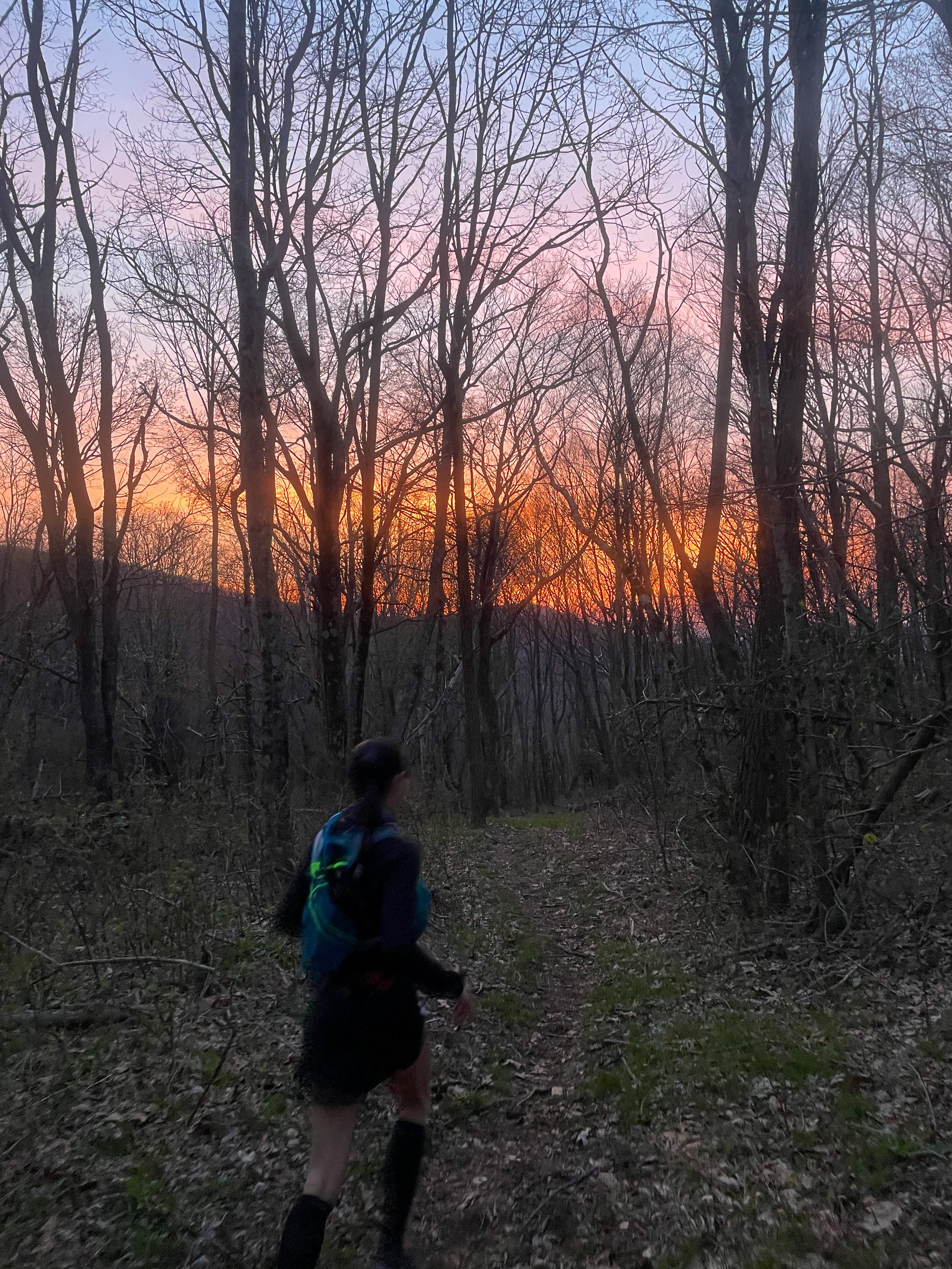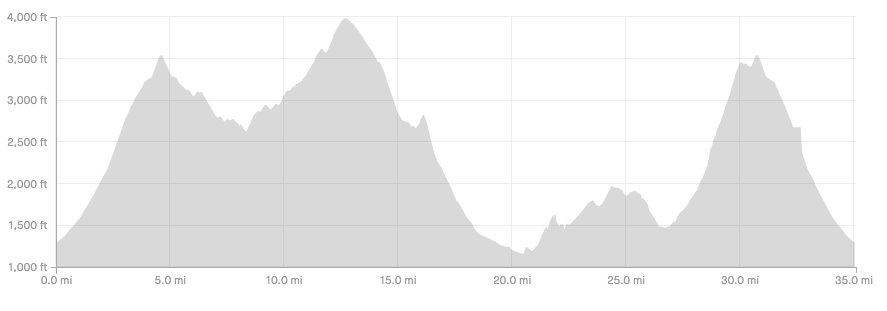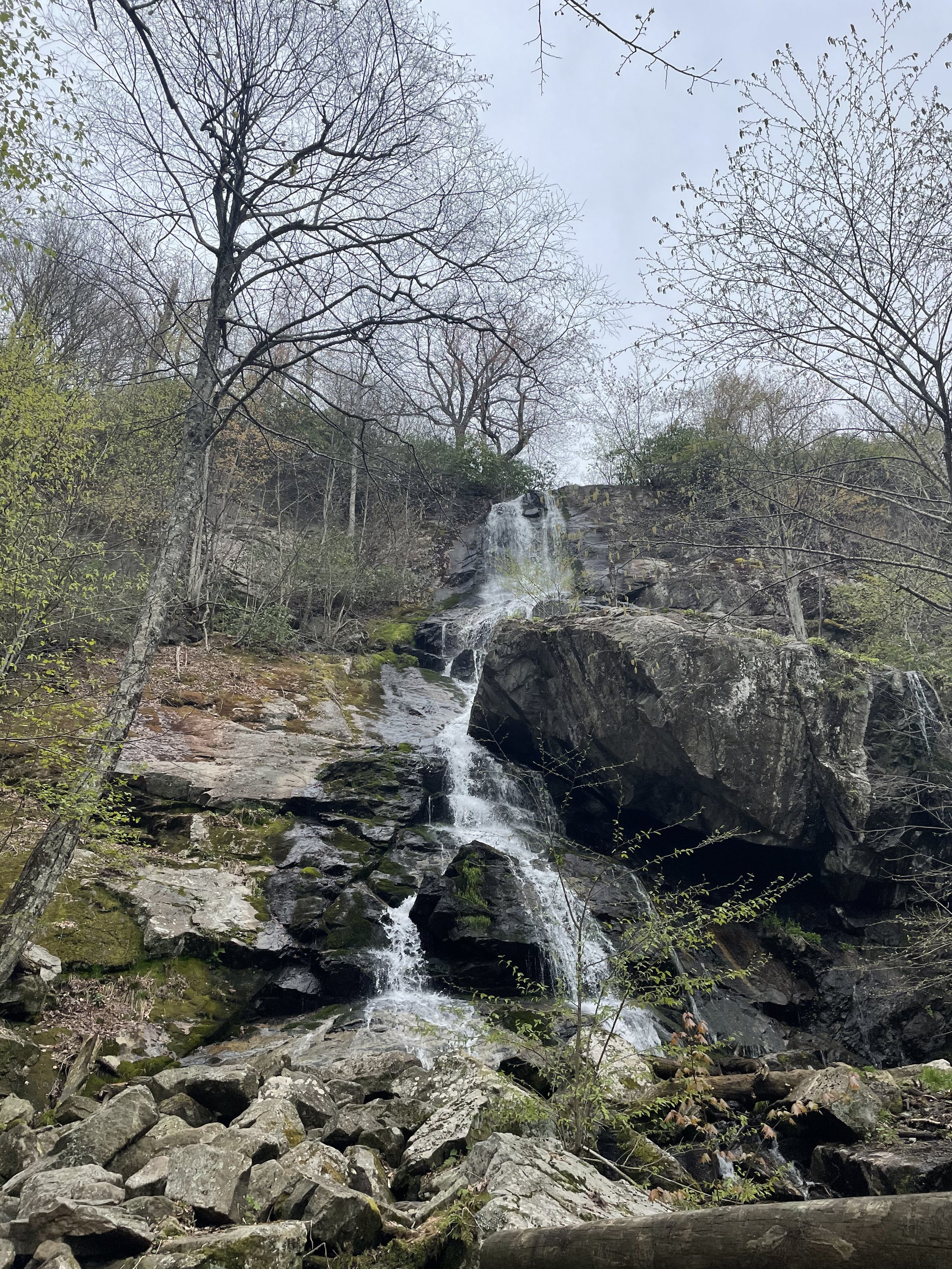Promise Land 50K++ Race Report
/The Promise Land 50K++ is a long-standing, well-respected ultra trail run in the Jefferson National Forest near Lynchburg, Bedford, and Roanoke, Virginia. This 2021 version took place on April 24 with plenty of trail runners champing at the bit to race since the 2020 event was cancelled.
At 5:30 AM we started in darkness at about 1300 feet elevation with a roughly three-mile climb up a gravel road from the Promise Land Youth Camp. It was runnable at the bottom but became too steep for anything but hiking by the time the final half-mile rolled around. I was surprised to see how many people were just blasting this entire section. Being a spring event, that felt like a sure way to guarantee an awful experience for me, so I held back.
Then there’s a short section of slightly technical singletrack alongside Onion Mountain where I finally topped out the first climb around 50 minutes for 4.5 miles at an altitude around 3500 feet. Just a measly 2200 feet of gain in less than an hour. Yeesh. This leads to over three miles of gradual grassy service road descent on the side of Apple Orchard Mountain. Fortunately it drops only to 2600 feet and not back to valley levels. Still, so many people were flying on these open, non-technical sections. It was early, so patience felt like the best course of action as I tried to settle into a sustainable rhythm. The view of the sunrise was fantastic.
Around the 8.5 mile point, the trail starts climbing as everyone must reach the top of Apple Orchard Mountain. Before reaching the top, racers have a midway stop at the Reed Creek aid station at 10 miles where I refilled a bottle, took down a cup of Coca-Cola, and some chips, expecting the next aid station to come quickly. There’s more non-technical - but now steeper - grassy, wide service road to climb up to the Blue Ridge Parkway. I’m getting a feeling that this course is different from the types of trail runs I’m accustomed to.
Crossing the parkway, we reached the high point of the course at nearly 4000 feet and began a long, crushed gravel road (still non-technical) descent toward the Sunset Fields aid station. Some people were really rocking the pace as the runners I followed up the climb were drifting further from my sight. I was trying to hold back a bit to save my quads for later.
totally straight and flat
super flat
Now for the biomechanics lesson you didn’t ask for but need to hear. The destructive muscular impact of terrain elevation fluctuation is one of the hardest things to explain to road runners and non-ultrarunners. In ultras, there’s a significant likelihood that your quads will begin to hurt and/or simply have a hard time holding you up, especially on descents. It commonly forces people into walking because running feels untrustworthy. You can thank something called eccentric demand for that failure. A couple things increase the eccentric demand in the quadriceps muscles: 1) longer strides that make the initial point of foot contact further from the body, 2) downhills, especially steep downhills. Eccentric demand is far less with climbing than descending, but climbing gets all the sexy vertical appeal.
The bigger those eccentric demands as the hours pass, the faster your quads will begin to either hurt or straight up experience a reduction in their force generating capacity. So when you see a course elevation profile or some big elevation gain number, it’s just as important to consider the elevation loss and the grades because those are the most muscularly demanding periods of time, even though they might not require the most cardiorespiratory fitness. It’s definitely not free speed like coasting on a bicycle. Across a several hour mountainous ultra, there’s a good chance that hours of time will be spent descending, slowly working the quads toward failure. Could you run the descents faster? Yes, many times. But it’s not a great idea if you want your quads to do their job well, on all terrains, as long as possible.
Anne greeted me at the aid station, and I proceeded to complain a bunch about not being able to do anything with gloves on and being too cold to get rid of my jacket but I did get to eat some bacon!
Now for the descent off the other side of Apple Orchard Mountain. Finally, after 13 miles of waiting, the kind of running that I am accustomed to and half okay at: technical, rocky, singletrack where you have to constantly think about where to put your feet or you’re gonna fall and break your face. Considering that my GPS watch keeps taunting me, telling me that my “fitness age” is that of a 56 year old, I need all the advantages I can find.
The descent down Cornelius Creek Trail has varying degrees of technicity and steepness but unfortunately couldn’t go on forever. High on the westward ridge above is the famous Appalachian Trail, though we never ran on it. A small group of us arrived at the Cornelius Creek aid station around mile 18. I reluctantly refilled a bottle with Tailwind and proceeded down the gravel road that became a paved road while still impressed with the many people moving quickly.
The downward trend finally stops as we exited from the paved road onto an unmarked and seemingly random trail that leads up to the Colon Hollow aid station around mile 21 (after a bit of climbing on a true singletrack, which I really enjoyed). I grabbed part of PB&J and some Coke, but neither felt very uplifting. The next five-mile section proceeding along the side of Pine Mountain was not my favorite. More non-technical grassy forest service road with a few hundred feet of large roller climbing to make you feel sluggish with a sprinkle of poison ivy for good measure.
My stomach wasn’t fantastic. By the time I jostled my way around to the Cornelius Creek aid station for the second time, at mile 26, it really wasn’t cooperating. I asked the volunteer if they had a Porta-John and he said, “nope, but we have the woods and I have some toilet paper.” So I took those six tiny squares and scampered myself off into the brush for a few minutes of alone time leaning against a tree with a rock as a kickstand for my arm, just in case the tired legs gave way, and then continued on with the adventure, knowing the unforgiving terrain that was about to come.
The Apple Orchard Falls Trail is all up. It starts out runnable and a bit technical but becomes increasingly steep and rocky with several impromptu rock staircases. And you know, there’s over a marathon worth of miles on your legs so they hurt a bit. It becomes nearly all power hiking for the uppermost two miles. For one of those miles, the saving grace is that it is pretty. There’s dark green moss covering the boulders throughout the creek and the falls themselves are impressive.
But once you pass the falls, there’s less foliage and fewer flowers that might otherwise distract you from another mile of hard hands-on-knees climbing. Part of this includes several not-so-lovely wooden block stairs rebarred into the ground but that is probably easier to deal with than eroding soil. Eating real food sounded difficult while panting, so I popped a nasty energy gel, which I could tell prevented a full bonk but made me queasy. I could eventually hear cheers at the next aid station, but there was easily another 15-20 minutes of work to do before getting there. Nearing the top, I attempted to run/shuffle a flatter section and caught my left foot on a rock, which promptly threw me to the ground in a heap. It hurt my elbow a little but falling uphill is generally the preferred option if I get to pick.
Another hundred yards and the Sunset Fields volunteers greeted me for the second time along with Anne, who was not loving the day of cold weather. I grabbed a little more bacon from her, more Coke from the volunteers, and a few chips. Upon leaving the aid station and crossing the Blue Ridge Parkway, there was a feeling of relief to be nearly done, and I tried to shove in the chips. Unfortunately, this prompted another feeling: intense nausea. So I ended up hunching over to hurl. Normally if this was to happen, just a couple heaves and I’m good to go but in this case it was more in the neighborhood of 6-8 heaves and left me questioning when or if it was going to stop. I’m blaming the energy gel combined with the Coke.
One of the runners I’d spent some time with earlier, Ben, came by and happened to meet up with his pacer for the final chunk. I figured I should jump on the train, hoping my stomach would settle now that it was theoretically empty. The singletrack was semi-technical and intersected back to a section we’d already climbed up in the earliest part of the course. I was moving fast with 7 to 8 minute miles and actually felt good enough to pass a couple folks. Too bad I didn’t vomit earlier. Then I caught my left foot again on an embedded rock. Thank goodness I was keeping a quick turnover that kept me from going down, but it sure as heck scared me.
The course finally comes back to the same starting gravel road (Overstreet Creek Road) for a high-speed descent on a broken body. It’s hard to hold back too much knowing that the finish line is now so close and really my quads felt good since the GI system was more of the limiter today. Striding into the finish back down at 1300 feet, I picked up the well-earned finisher’s award of custom Patagonia shorts, taking some pride in beating Anne back to the start on foot thanks to that smoking downhill.
In hindsight, the course was not what I expected. The climbs and descents were long, which I don’t mind, but for the most part, they are too runnable at high speeds for my liking, with the exception of that final climb. The majority of the course felt like a fast grassy forest service road, though there was plenty of gravel road and a little paved road too. It is definitely a real runner’s course and I don’t currently have the turnover for blazing such fast things! That’s ok. It was still challenging and nice to check off a classic event on an early spring day.
You can tell the event has functioned well for a while. It’s a well-oiled machine with great course markings and plenty of volunteers (even a couple at intersections in the woods where people might get confused or attempt to cut the course). Do watch out for ticks. I ended up having one embed itself far into my shin which caused an unfortunate cellulitis in the few days afterward. Would I do it again? Sure. But probably not for a couple years because my mind (and gut) took a beating that might take a little extra time to forget.











